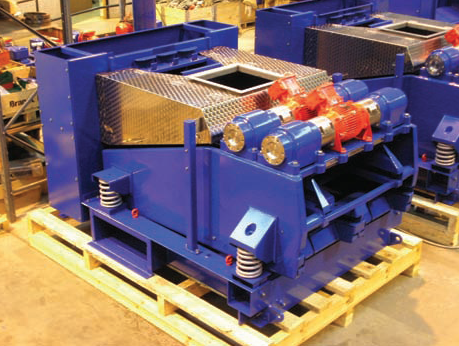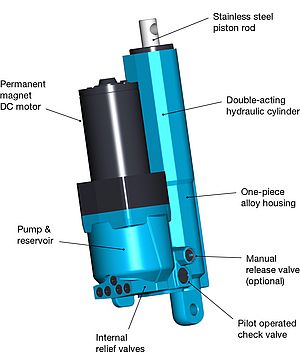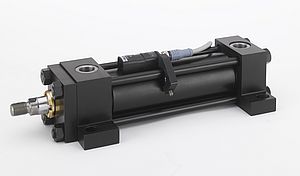Part of National Oilwell Varco, a worldwide leader in the supply of major mechanical components for land and offshore drilling rigs, NOV Brandt specialises in the manufacture of shale shakers for solids control. To increase the versatility and efficiency of its shakers, which are used to separate solids from the liquid component of drilling mud, NOV Brandt makes provision for multi-speed operation, using tough and reliable AC690+ inverters from Parker SSD Drives.
On every type of oil and gas drilling rig, drilling mud is a valuable commodity that performs many functions. Mud is, for example, pumped through the drill string so that it sprays out of nozzles on the drill bit, thereby keeping the bit cool and clean. It then flows back to the surface in the space between the drill string and the sides of the hole being drilled. In doing so, it carries with it the cuttings – chunks of rock – produced by the drilling process.
Because the mud is so valuable and useful, it is not discarded on its return to the surface, instead it is reused. However, returning used mud to the drill string without treatment would create problems, as the cuttings it carries would rapidly erode the drill bit. The mud is, therefore, treated before reuse by a solids control process that separates out the cuttings from the liquid component.
This process is most commonly carried out with a shale shaker, which operates by passing the contaminated mud through a vibrating basket that is equipped with specially designed screens. The shakers are motor driven, and typically generate forces in the range 5G to 8G to ensure effective separation of the solids and the mud.
One of the world’s largest suppliers of shale shakers, NOV Brandt manufactures a wide range of models to suit different requirements. The most popular model made at its Aberdeen plant is equipped with two three-phase motors of up to 3.0kW each, which are designed to run at their nominal rated speed when used on a 60Hz supply. Significant benefits can, however, in some circumstances, be gained by operating the shaker at higher and lower than normal speeds.
In addition, controlled starting to minimise the stresses on the shaker and the starting current surge on the supply – which on oil rigs is usually derived from local generator sets – is also highly desirable. The most convenient and cost effective way of meeting these requirements is to use an AC variable speed drive. For the current range of shale shakers, drives in the AC690+ integrator range are being used.
NOV Brandt utilise an 11kW drive, capped at 7.5kW with their shale shaker because an exceptionally high starting torque is required to get the off-centre weights moving from a stationary position. Overrating the drives also helps them to cope with the very tough operating conditions associated with this application. In some parts of the world, the shakers have to operate in ambient temperatures down to -20ºC and up to +50ºC.
A particular problem that the drives have to cope with is the very poor quality of the power supply on many oil rigs. Engineers from NOV Brandt have, for example, found that it is by no means unusual to encounter high-energy switching transients of around 1.4kV on nominal 460V supplies.
It would be unreasonable to expect any standard AC drive to cope with transients of this magnitude straight out the box and some issues did need to be addressed when first used. Parker SSD responded to this, even sending one of its own engineers to a rig to evaluate the problem fully. As a result, NOV Brandt quickly arrived at a practical and cost-effective solution, and the AC690+ drives currently in use are proving to be extremely reliable.
NOV Brandt configures the drives to allow the shale shakers to be operated at three different speeds. For much of the time, the motors run at a supply frequency of 60 Hz, since this provides effective solids control under most conditions.
When the drill is operating in “top-hole” conditions with Water Based Muds (WBM), however, larger diameter holes and higher penetration rates are used. This results in the shaker needing to operate at a higher speed in order to process as much mud and cuttings as possible. In this situation the cuttings need to be transported off the shaker screens as quickly as possible and this is achieved by increasing the frequency of the motor supply to 67Hz.
Conversely, when the drilling with Oil Based Muds (OBM) further down the well the penetration rates decrease and the hole diameter is smaller, hence the amount of mud required is reduced. At this stage it is highly desirable, due of the value of the OBM to separate as much of it from the cuttings as possible. To achieve this, the cuttings need to remain on the shaker screen for a longer time and this is done by reducing the motor supply frequency to 55Hz.
Depending on the end user’s requirements, the drive may be mounted either in a safe area switchroom or close to the shaker in the hazardous area. In the latter case, the drive has to be housed in an EEx’d’ enclosure developed by NOV Brandt and tested and approved by EECS/BASEEFA. No direct ventilation of the drives is possible with this explosion proof arrangement but, even in high ambient temperatures, their operation continues to be dependable and problem free. It’s hard to imaging tougher operating conditions for drives than on the shale shakers, yet, even though NOV Brandt supply hundreds of shakers a year, the failure rate is very small.






















